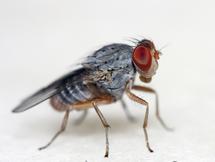Fruit Flies
 Common Name:Fruit Flies
Common Name:Fruit Flies
Scientific Name:Drosophila melanogaster
Introduction:Fruit Flies are small yellow-brown, with brick red eyes and transverse black rings across the abdomen. They are slow-flying insects usually found or associated with over-ripened fruit, decaying vegetables, spill and fermenting alcohol , sugary base liquid product and other decaying product. These insects are most abundant in the summer and are a common nuisance pests to restaurants, grocery stores, fruit markets, pubs , homes, and other locations that may attract these insects with fermenting or rotting vegetative matter.
Biology: The females are about 2.5mm long while the males are slightly smaller with darker backs. Males are easily distinguished from females based on colour differences, with a distinct black patch at the abdomen. Females lay about 500 eggs (20 per day) into rotting fruit or other decaying and fermented matter. The eggs, which are about 0.5 millimetres long, hatch after 12–15 hours (at 25 °C or 77 °F) The resulting larvae grow for about 4 days (at 25 °C) The developmental period varies with temperature, as with many other species. The shortest development time (egg to adult), 7 days, is achieved at 25-28°C (77 °F -82 °F). Development times increase at higher temperatures (11 days at 30 °C or 86 °F) due to heat stress.
The larvae feed primarily on the yeast found in fermenting, liquefying product i.e. over-ripe and rotting fruits and vegetables, the remains beer at the bottom of cans place in bins for recycling, the drip from the beer taps, stagnant water in cellars, water trap in the insulation covering the beer lines, decaying substance such as wet mops and accumulations of food particles behind or under kitchen equipment. Drains, which have a gelatinous growth of scum, can also support an infestation of fruit flies. Larvae typically pupate outside of the food source after feeding for about one week or less. The adult flies emerge and become sexually active within two days.
Management:Removal of an infestation can be difficult, as larvae may continue to hatch in nearby in decaying and rotting matter even as the adult population is culled. Elimination of breeding sites is paramount. Although insecticidal fogs and sprays will kill adult fruit flies, the larvae will continue to develop and new adults will emerge unless potential food sources are discovered and removed. The adult's small size, allow them to gain access through standard window screening. Installation of 16 mesh or finer screening will reduce the number of flies that enter a the building Outside, gather and remove fallen fruit such as apples, pears etc. At home store fruits and vegetables in a refrigerator, rinse cans, jars, and bottles prior to recycling to remove potential food sources.




























